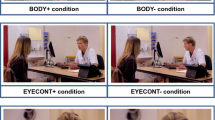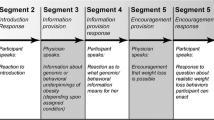Abstract
This paper reviews the literature on the nonverbal aspects of physician-patient interaction, focusing on how expectations about patient involvement are conveyed and negotiated by physicians and patients. Important outcomes of this process, such as satisfaction, adherence, and patient health, are examined. A model of physician-patient negotiation involving four interaction styles is presented to examine the negotiation process and the effects of patient involvement on outcomes.
Similar content being viewed by others
References
Beisecker, A. E. (1990). Patient power in doctor-patient communication: What do we know?Health Communication, 2, 105–122.
Benarde, M. A., & Mayerson, E. W. (1978). Patient-physician negotiation.Journal of the American Medical Association, 239, 1413–1415.
Blanchard, C. G., Labrecque, M. S., Ruckdeschel, J. C., & Blanchard, E. B. (1988). Information and decision-making preferences of hospitalized adult cancer patients.Social Science & Medicine, 27, 1139–1145.
Brody, D. S. (1980). The patient's role in clinical decision making.Annals of Internal Medicine, 93, 718–722.
Buller, D. B., & Street, R. L. (1992). Physician-patient relationships. In R. S. Feldman (Ed.),Applications of nonverbal behavioral theories and research (pp. 119–141). Hillsdale, NJ: Erlbaum.
Coker, D. A., & Burgoon, J. K. (1987). The nature of conversational involvement and nonverbal encoding patterns.Human Communication Research, 13, 463–494.
Cypress, B. K. (1980).Characteristics of visits to female and male physicians. Vital and Health Statistics, series 13, no. 49. Hyattsville, MD: U.S. Department of Health and Human Services.
DiMatteo, M. R. (1993). Expectations in the physician-patient relationship: Implications for patient adherence to medical treatment recommendations. In P. D. Blank (Ed.),Interpersonal expectations: Theory, research, and applications (pp. 296–315). New York: Cambridge University Press.
DiMatteo. M. R., & DiNicola, D. D. (1982).Achieving patient compliance. New York: Pergamon.
DiMatteo, M. R., & Hall, J. A. (1979). Nonverbal decoding skill and attention to nonverbal cues: A research note.Environmental Psychology and Nonverbal Behavior, 3, 188–192.
DiMatteo, M. R., Reiter, R. R., & Gambone, J. C. (1994). Enhancing medication adherence through communication and informed collaborative choice.Health Communication, 6, 253–265.
Ditto, P. H., & Hilton, J. L. (1990). Expectancy processes in the health care interaction sequence.Journal of Social Issues, 46(2), 97–124.
Eisenberg, J. M. (1979). Sociologic influences on decision-making by clinicians.Annals of Internal Medicine, 90, 957–964.
Faden, R. R., Becker, C., Lewis, C., Freeman, J., & Faden, A. I. (1981). Disclosure of information to patients in medical care.Medical Care, 19, 718–733.
Feller, B. A. (1979).Characteristics of general internists and the content of care of their patients (HRA-79-652). Washington, DC: U.S. Department of Health, Education, and Welfare.
Fischbach, R. L., Sionelo-Bayog, A., Needle, A., & DelBanco, T. L. (1980). The patient and practitioner as co-authors of the medical record.Patient Counseling and Health Education, 1, 1–5.
Fisher, S. (1983). Doctor talk/patient talk: How treatment decisions are negotiated in doctor/patient communication. In S. Fisher & A. Todd (Eds.),The social organization of doctor-communication (pp. 135–157). Washington, DC: Center for Applied Linguistics.
Friedman, H. S. (1979). Nonverbal communication between patients and medical practitioners.Journal of Social Issues, 35(1), 82–99.
Gambone, J. C., & Reiter, R. R. (1991). Quality improvement in health care.Current Problems in Obstetrics, Cynecology, & Fertility, 14, 151–175.
Greene, M. G., Adelman, R. D., Charon, R. & Hoffman, S. (1986). Ageism in the medical encounter: An exploratory study of the language and behavior of doctors with their old and young patients.Language and Communication, 6, 113–124.
Hall, J. A. (1984).Nonverbal sex differences: Communication accuracy and expressive style. Baltimore: Johns Hopkins University Press.
Hall, J. A., Irish, J. T., Roter, D. L., Ehrlich, C. M., & Miller, L. H. (1994). Gender in medical encounters: An analysis of physician and patient communication in a primary care setting.Health Psychology, 13, 384–392.
Hall, J. A., Roter, D. L., & Katz, N. R. (1988). Meta-analysis of correlates of provider behavior in medical encounters.Medical Care, 26, 657–675.
Harrigan, J. A., & Rosenthal, R. (1983). Physicians' head and body positions as determinants of perceived rapport.Journal of Applied Social Psychology, 13, 496–509.
Harrigan, J. A., Oxman, T. E., & Rosenthal, R. (1985). Rapport expressed through nonverbal behavior.Journal of Nonverbal Behavior, 9, 95–110.
Haug, M., & Lavin, B. (1983).Consumerism in medicine: Challenging physician authority. Beverly Hills, CA: Sage.
Heath, C. (1984). Participation in the medical consultation: The co-ordination of verbal and nonverbal behaviour between the doctor and patient.Sociology of Health & Illness, 6, 311–338.
Hooper, E. M., Comstock, L. M., Goodwin, J. M., & Goodwin, J. S. (1982). Patient characteristics that influence physician behavior.Medical Care, 20, 630–638.
Kaplan, S. H., Greenfield, S., & Ware, J. E., Jr. (1989). Assessing the effects of physician-patient interactions on the outcomes of chronic disease.Medical Care, 27, S110-S127.
Kasl, S. V. (1975). Issues in patient adherence to health care regimens.Journal of Human Stress, 1, 5–17.
Kincey, J., Bradshaw, P., & Ley, P. (1975). Patient's satisfaction and reported acceptance of advice in general practice.Journal of the Royal College of General Practitioners, 25, 558–566.
Leigh, H., & Reiser, M. F. (1980).The patient: Biological, psychological, and social dimensions of medical practice. New York: Plenum Press.
Ley, P. (1986). Cognitive variables and non-compliance.Journal of Compliance in Health Care, 1(2), 171–188.
Mathews, J. J. (1983). The communication process in clinical settings.Social Science & Medicine, 17, 1371–1378.
Patterson, M. L. (1983).Nonverbal behavior: A functional perspective. New York: Springer-Verlag.
Patterson, M. L. (1984). Intimacy, social control, and nonverbal involvement: A functional approach. In V. J. Derlega (Ed.),Communication, intimacy, and close relationships (pp. 105–132). Orlando, FL: Academic Press.
Pendleton, D. A., & Bochner, S. (1980). The communication of medical information in general practice consultations as a function of patients' social class.Social Science & Medicine, 14A, 669–673.
Rost, K., Carter, W., & Inui, T. (1989). Introduction of information during the initial medical visit: Consequences for patient follow-through with physician recommendations for medication.Social Science & Medicine, 28, 315–321.
Roter, D. L., & Hall, J. A. (1992).Doctors talking with patients/Patients talking with doctors: Improving communication in medical visits. Westport, CT: Auburn House.
Roter, D. L., Hall, J. A., & Katz, N. R. (1988). Patient-physician communication: A descriptive summary of the literature.Patient Education and Counseling, 12, 99–119.
Roter, D., Lipkin, M., & Korsgaard, A. (1991). Sex differences in patients' and physicians' communication during primary care medical visits.Medical Care, 29, 1083–1093.
Schulman, B. A. (1979). Active patient orientation and outcomes in hypertensive treatment: Application of a socio-organizational perspective.Medical Care, 17, 267–280.
Shapiro, A. (1960). A contribution to a history of the placebo effect.Behavioral Science, 5, 109–135.
Shreve, E. G., Harrigan, J. A., Kues, J. R., & Kagas, D. K. (1988). Nonverbal expressions of anxiety in physician-patient interactions.Psychiatry, 51, 378–384.
Siegman, A. W. & Feldstein, S. (Eds.) (1987).Nonverbal behavior and communication. Hillsdale, NJ: Erlbaum.
Speedling, E. J., & Rose, D. N. (1985). Building an effective doctor-patient relationship: From patient satisfaction to patient participation.Social Science & Medicine, 21, 115–120.
Stewart, M. (1983). Patient characteristics which are related to the doctor-patient interaction.Family Practice, 1, 30–35.
Stewart, M. (1984). What is a successful doctor-patient interview? A study of interactions and outcomes.Social Science & Medicine, 19, 167–175.
Stiles, W. B., Putnam, S. M., Wolf, M. H., & James, S. A. (1979). Verbal response mode of profiles of patients and physicians in medical screening interviews.Journal of Medical Education, 54, 81–89.
Stone, G. C. (1979). Patient compliance and the role of the expert.Journal of Social Issues, 35(1), 34–59.
Street, R. L. (1990). Communication in medical consultation: A review essay.Quarterly Journal of Speech, 76, 315–357.
Street, R. L., & Buller, D. B. (1987). Nonverbal response patterns in physician-patient interactions: A functional analysis.Journal of Nonverbal Behavior, 11, 234–253.
Street, R. L., & Buller, D. B. (1988). Patients' characteristics affecting physician-patient nonverbal communication.Human Communication Research, 15, 60–90.
Street, R. L., & Wiemann, J. M. (1987). Patient satisfaction with physician's interpersonal involvement, expressiveness, and dominance. In M. L. McLaughlin (Ed.),Communication yearbook (Vol. 10, pp. 591–612). Beverly Hills, CA: Sage.
Strull, W. M., Lo, B., & Charles, G. (1984). Do patients want to participate in medical decision making?Journal of the American Medical Association, 252, 2990–2994.
Svarstad, B. L. (1974).The doctor-patient encounter: An observational study of communication and outcome. Unpublished doctoral dissertation, University of Wisconsin, Madison.
Trilling, J. S., & Jaber, R. (1993). Formulation of the physician/patient impasse.Family Systems Medicine, 11, 281–286.
Wagener, J. J., & Taylor, S. E. (1986). What else could I have done? Patients' responses to failed treatment decisions.Health Psychology, 5, 481–496.
Waitzkin, H. (1985). Information giving in medical care.Journal of Health and Social Behavior, 26, 81–101.
West, C. (1984).Routine complications: Troubles with talk between doctors and patients. Bloomington, IN: Indiana University Press.
Winefield, H. R., & Murrell, T. G. (1991). Speech patterns and satisfaction in diagnostic and prescriptive stages of general practice consultations.British Journal of Medical Psychology, 64, 103–115.
Author information
Authors and Affiliations
Additional information
We would like to thank Valerian Derlega and the two reviewers, Debra L. Roter and Richard L. Street, for their helpful comments.
Rights and permissions
About this article
Cite this article
Lepper, H.S., Martin, L.R. & DiMatteo, M.R. A model of nonverbal exchange in physician-patient expectations for patient involvement. J Nonverbal Behav 19, 207–222 (1995). https://doi.org/10.1007/BF02173081
Issue Date:
DOI: https://doi.org/10.1007/BF02173081




